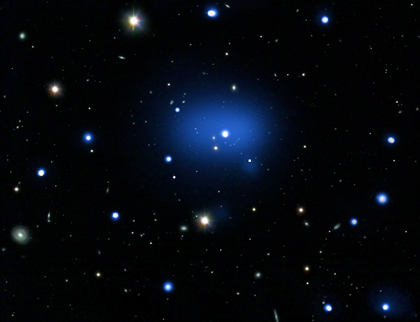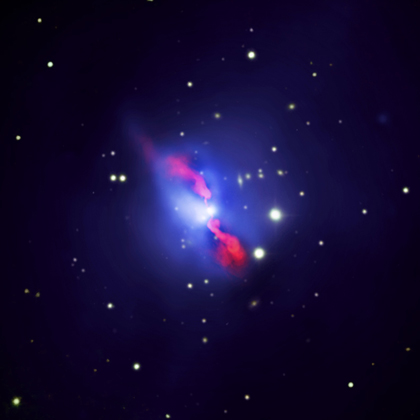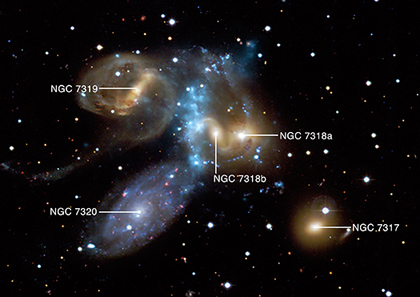Submitted by chandra on Thu, 2009-10-22 08:52

This is a composite image of the most distant galaxy cluster yet detected. This image contains X-rays from NASA's Chandra X-ray Observatory, optical data from the Very Large Telescope (VLT) and optical and infrared data from the Digitized Sky Survey. This record-breaking object, known as JKCS041, is observed as it was when the Universe was just one quarter of its current age. X-rays from Chandra are displayed here as the diffuse blue region, while the individual galaxies in the cluster are seen in white in the VLT's optical data, embedded in the X-ray emission.
Submitted by chandra on Mon, 2009-09-14 13:45

This composite image of the Hydra A galaxy cluster shows 10-million-degree gas observed by Chandra in blue and jets of radio emission observed by the Very Large Array in pink. Optical data (in yellow) from the Canada-France-Hawaii telescope and the Digitized Sky Survey shows galaxies in the cluster.
Submitted by chandra on Tue, 2009-07-21 13:25
Recently, we released a beautiful image of Stephan's Quintet, showing a group of galaxies and the effects of a galactic collision. In our caption we noted that NGC 7320, the blue galaxy near the bottom of the image, is not a member of the group but is located much closer to the Earth. This is because, as stated in the journal paper by Ewan O'Sullivan, NGC 7320 has a much lower redshift than the other galaxies, and a lower redshift means a smaller distance according to standard cosmology.

Submitted by chandra on Thu, 2009-07-09 11:07
This beautiful image gives a new look at Stephan's Quintet, a compact group of galaxies discovered about 130 years ago and located about 280 million light years from Earth. The curved, light blue ridge running down the center of the image shows X-ray data from the Chandra X-ray Observatory. Four of the galaxies in the group are visible in the optical image (yellow, red, white and blue) from the Canada-France-Hawaii Telescope.
Submitted by chandra on Thu, 2009-04-16 12:02
This composite image shows the massive galaxy cluster MACSJ0717.5+3745 (MACSJ0717, for short), where four separate galaxy clusters have been involved in a collision, the first time such a phenomenon has been documented. Hot gas is shown in an image from NASA's Chandra X-ray Observatory and galaxies are shown in an optical image from NASA's Hubble Space Telescope. The hot gas is color-coded to show temperature, similar to a temperature map of the Earth given in a weather forecast.
Submitted by chandra on Wed, 2009-03-11 13:13
This composite image of the Medusa galaxy (also known as NGC 4194) shows X-ray data from NASA's Chandra X-ray Observatory in blue and optical light from the Hubble Space Telescope in orange. Located above the center of the galaxy and seen in the optical data, the "hair" of the Medusa -- made of snakes in the Greek myth -- is a tidal tail formed by a collision between galaxies. The bright X-ray source found towards the left side of Medusa's hair is a black hole.
Submitted by chandra on Mon, 2008-03-17 15:58
Just as astronomers were getting used to the idea of not knowing what dark matter is, they got a completely different surprise at the end of the 20th century. Instead of slowing down after the Big Bang, the expansion of the Universe was found to be accelerating. Astronomers quickly did what they always do when they come up with something mysterious: they gave it a name. Now, we call whatever it is pushing the Universe apart "dark energy", but the truth is no one knows what it is.
Submitted by chandra on Thu, 2008-03-06 16:13
When you look up at the night sky, you see a lot of things glowing like stars, planets, and galaxies. So it might sound strange to hear that most of the Universe is actually dark. The truth is the protons, neutrons and electrons that make up everything we can see - and that means with every telescopes we've got -- accounts for only about 4% of the mass and energy of the Universe. The rest is dark and mysterious. More specifically, about 70% of the Universe is what is known as dark energy; about 26% is so-called dark matter.
Submitted by chandra on Thu, 2007-08-23 15:03
Submitted by chandra on Thu, 2007-08-23 14:47
A lot of kids (and maybe adults) are scared of the dark. Most of us get over it once we realize there isn’t a monster hiding in the closet or under the bed. But then scientists announce another finding about dark matter and we all are back peering from under the sheets.
Pages